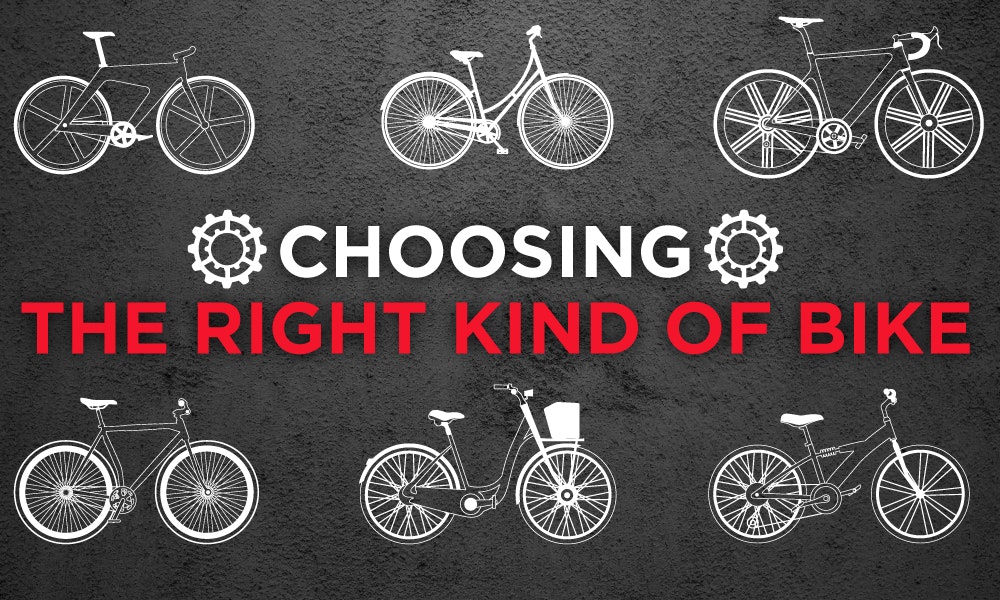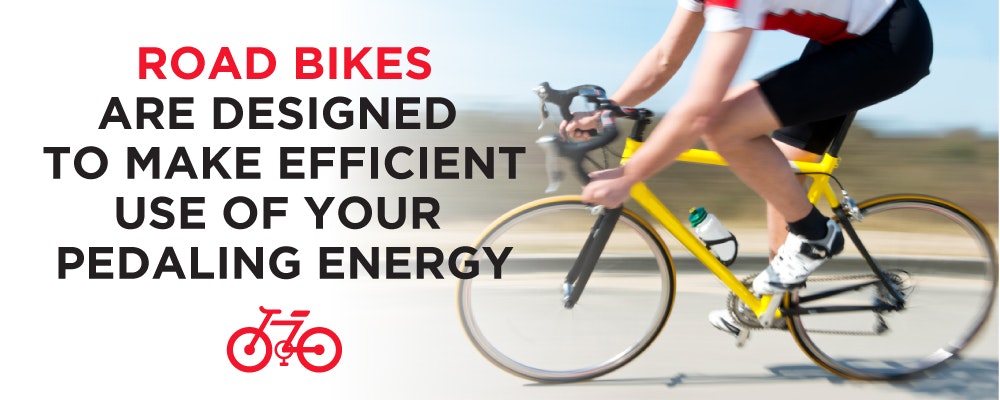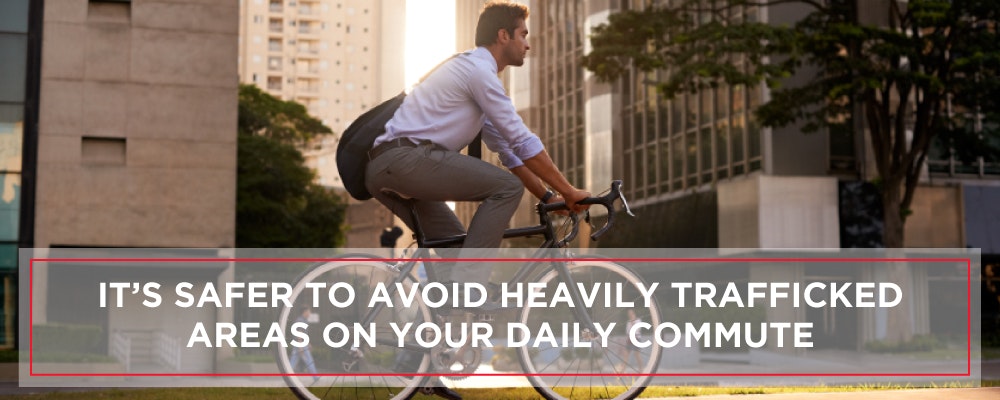A Whole Different Gear: Your Guide to Commuter Biking
The benefits of biking to work are no secret. Ask any regular commuter, and they’ll likely gush over the great views, the warm sun on their faces and the incredible exercise that keeps them in great shape with little extra effort. Add to that the lack of time spent in gridlocked traffic and the reduced stress levels associated with it and no wonder you’ve got a favourite mode of transport.
Thinking about making the switch to commuter biking? You’ll be glad you did. With Ride2Work Day coming up on Oct. 14, there’s no time like the present to get started. BikeExchange has got the scoop on what you need to know, so check out our in-depth guide below.
Choosing the Right Bike

“So, what kind of bike do I need?”
It’s the first question on most would-be commuters’ minds, and with so many options available, it can be hard to know where to start. Do you prioritise speed and control over rugged durability? What about comfort? What makes some bikes more expensive than others?
When it comes to choosing the best commuter bike, there are three specific types that make for strong contenders:
Commuter/Urban Bikes
Don’t be misled by the name. While the term “commuter bike” suggests you need look no further for the perfect ride, these cycles aren’t necessarily the best fit for everyone. That said, they provide a great place from which to begin your search.
A commuter bike is well-rounded, with a relatively light weight reminiscent of a racing bike, yet with the stable and upright position of a mountain bike. Its geometry is built for comfort and speed, and many come equipped with wheel fenders to protect against dirt and water splashing. They’ll also often have a rear rack designed to hold a pannier, or gear bag/basket, making them a good choice for those transporting laptops, groceries, a fresh set of clothing and those other items you usually need to carry around with you.
Road Bikes
Sleek and swift, road bikes are designed to make efficient use of your pedalling energy. These are what racers typically use. Their light weight and streamlined design makes them perfect for commutes of any length, and they get you up to speed in no time at all. Be warned, though: Because road bikes tend to be fitted with narrow tyres in order to reduce traction resistance, they are often more susceptible to flats than some other models. Riders must be sure to keep a careful eye on the road ahead, and to avoid rocks, glass, potholes and other potential threats.

Mountain Bikes
Mountain bikes are often a bit more affordable than road bikes, owing to the latter’s lightweight-but-pricy aluminium or carbon fibre frames. While there’s no reason that they can’t be used for shorter daily commutes, be aware that mountain bikes require more energy output on your part – when compared to road and commuter bikes – due to their increased weight and rolling resistance. If you plan to ride many kilometres on flat and well-paved roads each day, a mountain bike might is probably not the ideal fit.
Hopefully, the differences are becoming clearer, and the choice less overwhelming. In order to decide on the right bike for your specific needs, ask yourself the following questions:
What sort of terrain will I ride on?
How long is my daily commute?
What’s my budget?
What’s my level of physical fitness?
Will I need to bring cargo?
Do I have a place to store the bike at work?
Break the process down like this, and it should be easy to see which of the above types is the best fit for you.
Commuter Biking Gear
Helmet
This is an absolutely essential piece of gear, and its use is mandatory by law in both Australia and New Zealand. A good bike helmet should fit securely against the head without feeling tight, and sit level atop your head rather than tilting backward or forward. Although helmets may come in small, medium and large sizes, nearly all models are adjustable to some degree, so don’t leave the house without the proper setting.

Remember that bike helmets, much like motorcycle helmets, are intended for single use. If you do strike yours in a collision, or even simply drop it onto a hard surface, it’s best to replace it immediately – even if it looks perfectly fine on the outside. The interior foam is designed to break apart in order to fully absorb the impact of a crash, and once that’s happened, the effectiveness of the helmet is greatly reduced in the future. The small extra expense is absolutely nothing compared to your health and well-being, so if there’s one time not to skimp on gear, this would be it.
Lights
Much like a car, bikes require lights visible from the front, side and rear in order to operate safely. In Australia bike lights are mandatory on bikes. Start by investing in a quality headlight, one that emits either a stable beam or a steady flash. You’ve got the option of either white or yellow light for this purpose, and your headlight must be visible at night from a distance of at least 100 metres. Some models may be powered by AA or AAA batteries, while others can actually run off the energy generated by operating the bike, much like a car’s battery.
Of course, it’s important not just to see, but also to be seen. The New Zealand Transport Agency requires cyclists to fit their bikes with a red or yellow rear reflector, as well as at least one rear-facing red light when cycling at nighttime. It’s also strongly recommended that you wear clothing with reflective material whenever operating your bike in low-light conditions.
Finally, don’t forget to pick up a couple of emergency lights. These are small, easily-detached LEDs that normally attach to your frame or handlebars with the assistance of a stretchy band. Although not particularly powerful in their own right, they are long-lasting, easy to carry and put out enough illumination to get you home if your main lights should fail.
Lock
When you’re out and about, your vehicle is your lifeline. It’s even more important to keep your bike safe from thieves when it’s your primary form of transportation. Because a well built, quality commuting bike does tend to run several hundred dollars (and into the thousands for a quality road or mountain bike), they can make for a tempting target.
Look to Amsterdam for an example: It’s one of the cycling capitals of the world, and a city where bicycle theft runs rampant. Commuters here often spend as much, or more, on their locks as they did on their bikes. Although this goal may be overkill for most New Zealanders, the fact remains that by using a flimsy lock, you risk losing your entire investment to an opportunistic crook.
You’ve got a few options when it comes to picking the best bicycle lock:
U-locks consist of a horseshoe-shaped metal piece and an extremely tough, bar-shaped locking mechanism. The unique shape prevents thieves from getting good leverage with crowbars and similar tools, while the mechanism itself resists blows from hammers and chisels.
Chain locks, with their tough chain-link core, are extra-resilient against hacksaws, chisels and anything that requires leverage. The primary downside is that they can be a bit heavy and bulky, so they may be a better fit for less-active riders who leave their bikes in the one place for most of the day.
Cable locks are very flexible and versatile, but not quite as tough as the other options. They are lightweight and easy to transport, and are often sufficient on their own to deter would-be thieves in low-crime areas. Just be aware that a truly determined criminal may be able to saw through the cable itself.
Remember to take a note of your bike’s serial number (usually underneath the frame near the bottom bracket) as this could help you identify it if ever you’re unfortunate enough to have it stolen.
Sunglasses/Goggles
While they may be mere optional accessories for the average pedestrian or driver, sunglasses and goggles are actually a very functional piece of cycling equipment. Any regular bike commuter should invest in a pair – not doing so is kind of like driving your car without a windshield. Even some generic shades from your local pharmacy are better than nothing, but ideally you’re looking for a few specific qualities that most off-the-shelf sunglasses won’t provide.
Lenses designed specifically for cycling should:
Sit close to your eyes, to protect them from dust and debris Allow sufficient airflow, to prevent the inside of the lens from fogging up Wrap around your entire face, so that the frame itself does not block any part of your field of vision
You may also notice that cycling lenses generally come in a variety of tint colours. These tints provide a filter for the light entering your eyes. There isn’t any one hue that is inherently best; rather, each has its own set of advantages.
Yellow lenses improve contrast and focus by filtering out blue light, making them a great pick for conditions that are regularly hazy and overcast. Amber is another commonly available tint colour, and functions very similarly to yellow: Its slightly darker shade is a good alternative for weather that’s just a bit sunnier.
Copper/bronze lenses are designed for optimal contrast in the widest range of lighting conditions, helping you to spot and avoid small hazards and debris on the road. They’re a solid all-around pick, and very fashion-neutral.
Green lenses strike a good balance between maintaining colour and increasing contrast. They’re another excellent all-around option, but if you anticipate very bright or cloudy conditions, you may be better served by something a bit more specialised.
Grey lenses are very straightforward: They’ll reduce brightness while preserving colour perception. In this way, they are somewhat like green lenses, but with a focus on glare rather than contrast. They’re a good pick for those who are light-sensitive, or who operate in very sunny conditions.
Blue lenses allow for better colour perception than many other tinted alternatives. Owing to their darker shade and the fact that they won’t do much to improve contrast, they aren’t very popular with those riders who regularly take their bikes off-road. That said, they remain a solid and stylish option for the average road-hugging commuter.
Clear lenses, as one might expect, don’t actually provide any coloured filtering of light before it hits your eyes. Savvy riders can take advantage of this by using non-tinted glasses at night, when safe vision demands that you make use of all of the illumination that’s available.
Planning Your Daily Commute
Your ideal bike commute isn’t necessarily the same route you’d take in a car or bus. It’s safer to avoid heavily trafficked areas, and if you can pick a route with dedicated bike lanes, so much the better. Before your first real ride to work, be sure to look over a map of the area, and to take a dry run. Try to do so on a quiet weekend if possible – you have less traffic to deal with, and it’ll be simpler to ease into the transition from driver to cyclist.

If you’re new to commuter biking, you’ve probably never ridden this frequently before, and that means there are safety considerations to learn. We’ve gone over some essential gear already, but there are a few additional small tools that every cyclist should get comfortable with. There’s no reason to risk being stranded kilometres away from home.
The bike pumps that you’re used to seeing are probably the floor models, which consist of a hose attached to a metal or plastic tube standing vertically on a base, and are operated by pressing down on the handle up top. These are great for home use, but not exactly convenient to take out on the road. For emergency situations where your tyre is low on air, try a short pump, which is usually about the size of a human hand and can easily fit within a backpack, pannier or even in your pocket.
A patch kit is invaluable when you’re in a tight spot. It typically contains several individual patches, a small tube of rubber cement and a bit of sandpaper to smooth out the surface before application. These kits are tiny and quite inexpensive, so there’s no reason not to carry one or two at all times.
You’ll also need a spare inner tube should you get a flat that just can’t be repaired on the spot.
Finally, sometimes you simply won’t be able to repair tyre damage on the fly. Having a spare tyre available may be the difference between getting home safe and not getting home at all. Of course, carrying one around isn’t always practical. One thing that you can do is to pick up a couple of spares, keeping one at home and one at the workplace, in order to handle incidents that occur close to either location. Should you prefer to play it extra safe, some manufacturers also produce folding bike tyres, which can often fit in backpacks and panniers.
Beyond the Commute
Getting comfortable with the idea of biking to work is a great first step, but plenty of people also look to other uses for their new ride. Your commuting bike gives you an easy way to run quick errands, blow off steam and just to enjoy the great outdoors.
With the right equipment, bicycles are perfectly capable of transporting groceries and other cargo. Most models that are specifically sold as commuter bikes come equipped with a rack above the rear wheel, on which you may place a rack trunk or hang panniers. Handlebar bags may fit some riders’ needs, and though small, are affordable and convenient to reach. Backpacks are another option, although be sure to find a lightweight and breathable one if you go this route: Wearing one while riding can potentially increase fatigue and cause you to sweat more.
If you’ve got a model that’s appropriate for off-road riding, like a mountain bike or a durable commuter bike, try exploring nature from a whole new angle. Even those of us who live in cities can often find expansive parks and nature trails within easy reach. Just remember that a road bike, with its thin tyres and hunched-down geometry, isn’t always the safest thing to take to the mountain slopes.
Ready to get started? Be sure to check out BikeExchange where you can find everything from full-frame cycles to helmets, lights, spare parts and attire. With more than 63,000 unique products, it’s your one-stop shop for the best city bikes and gear around.
Once you’ve got your bike, the journey has only just begun. Build your skills and keep up with the latest news and tips on our editorial section. Also, don’t forget to sign up for our email newsletter for all of our hottest promotions and competitions, sent directly to your inbox. We’ll see you on the road!
Keep up with news, reviews, interviews and more - follow us on Facie or subcribe to our email





